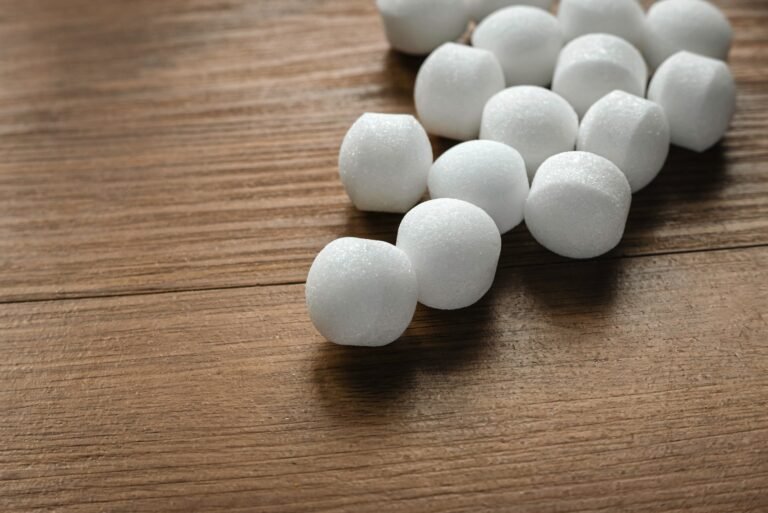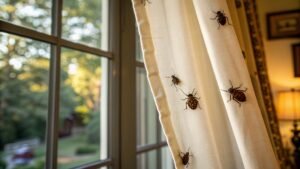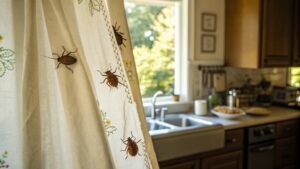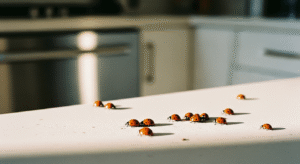In many households, rodent infestations can cause significant health and property issues. Moth balls have long been used as a repellent against mice, but opinions vary regarding their effectiveness and safety. This article analyzes the repellent properties of moth balls, discusses their active ingredients, reviews scientific studies on their effectiveness, and outlines necessary safety precautions. It also presents alternative methods for deterring mice, provides practical safety guidelines, and assesses environmental impacts. The aim is to provide homeowners with clear, evidence-based recommendations for informed rodentcontrol.
With rising concerns about health risks, toxic exposure, and environmental sustainability, choosing between traditional agents like moth balls and modern, eco-friendly solutions has become increasingly important.
Understanding the Repellent Properties of Moth Balls for Mice
Examine How Moth Balls Function as a Repellent Against Rodents
Moth balls work by sublimation, during which solid chemicals turn into vapors that are toxic or repellent to rodents. Their key active ingredients—naphthalene and sometimes paradichlorobenzene—release a strong odor that overwhelms mice’s sensory receptors. This disruption interferes with a mouse’s ability to locate food, water, and shelter. Research has indicated that even low concentrations of these vapors affect rodents, causing stress and disorientation. However, while moth balls can deter mice temporarily, the exposure needed for consistent control may also pose safety risks.
Identify the Active Ingredients in Moth Balls That Deter Mice
The primary ingredients are naphthalene and paradichlorobenzene. Naphthalene sublimates at room temperature, releasing a vapor that interferes with the chemo-sensory functions of mice. Paradichlorobenzene, though less volatile, supports the overall repellent effect. Both chemicals create an environment that is hostile to rodent habitation; however, their irritant properties raise concerns about human exposure, including risks of hemolysis and other adverse health effects.
Review Scientific Studies on Moth Balls' Effectiveness on Mice
Laboratory studies have shown that naphthalene vapor reduces food consumption and exploratory behavior in mice. Some controlled experiments report up to a 35% reduction in activity. Field studies, however, indicate that while moth balls may temporarily reduce rodent activity, they do not assure long-term eradication due to environmental variables and mouse habituation. Researchers recommend that moth balls be part of an integrated pest management strategy rather than the sole solution.
Assess Precautions When Using Moth Balls in Rodent Control
Due to the narrow safety margin of the chemicals, moth balls must be used only in unoccupied or infrequently accessed areas. They should be placed in sealed containers or sachets in storage spaces – never in living areas. Protective gear such as gloves and masks is recommended during handling. It is essential to follow manufacturer instructions and regional guidelines regarding placement, storage, and disposal while considering possible chemical interactions with other household substances.
Alternative Methods for Deterring Mice in Your Home
Explore Natural Repellents That Are Safe for Households
Natural repellents, including essential oils like peppermint, lavender, and eucalyptus, disrupt rodent scent trails without the toxicity issues of moth balls. In controlled tests, diluted peppermint oil has reduced mouse activity markedly. Other options include herbal sachets made of dried cloves, cinnamon, and rosemary, as well as diatomaceous earth, which damages rodent exoskeletons. Although these alternatives may require frequent reapplication, they offer a safer profile for homes with children and pets.
Implement Proper Sanitation Practices to Prevent Mice
Maintaining cleanliness is critical in rodent prevention. Promptly cleaning food spills, storing food in sealed containers, and reducing clutter can minimize hiding and nesting opportunities for mice. Studies indicate that strict sanitation routines can lower rodent encounters by as much as 60%. Effective sanitation not only diminishes rodent attractants but also helps reduce allergens and pathogens linked to rodent droppings.
Consider Physical Barriers to Block Mice From Entering
Sealing cracks, installing door sweeps, and repairing damaged screens are effective physical barriers against mice, which can squeeze through openings as small as a quarter inch. A thorough inspection of both the interior and exterior of the home can identify vulnerable areas. Combined with repellents and sanitation, physical barriers are a cornerstone of an integrated pest management strategy.
Evaluate the Role of Ultrasonic Devices in Pest Control
Ultrasonic devices emit high-frequency sound waves intended to disturb the rodent nervous system. While some users report a reduction in mouse activity, scientific evaluations are mixed. Their effectiveness may be diminished by obstacles and ambient noise. It is generally recommended to use them alongside other methods rather than relying on them exclusively.
Investigate the Efficiency of Traps Versus Repellents
Traps offer a direct method to capture or exterminate mice and often yield immediate, measurable results. Studies show traps can reduce rodent populations by up to 70% in moderately infested areas, though they require consistent monitoring and bait replacement. In contrast, repellents work preventively but may not remove existing rodents. An effective strategy typically combines traps, repellents, and physical measures for both immediate and long-term control.
Review Feedback From Users on Various Rodent Prevention Methods
Consumer feedback highlights that while moth balls provide a noticeable odor that deters mice, concerns about toxicity and residual smells persist. Natural repellents are generally favored for indoor use due to their mild scent and safety, though they require reapplication. Mechanical traps receive high marks for effectiveness, and ultrasonic devices, despite offering a non-chemical solution, have shown inconsistent results.
Analyze Cost-Effectiveness of Using Moth Balls Versus Traps
Moth balls are low in cost per unit but carry health risks that may increase overall expenses due to necessary safety measures. In contrast, traps have a higher initial cost but deliver direct removal of rodents with fewer side effects. A combined approach, using traps for immediate action and repellents for ongoing prevention, often proves to be the most cost-effective solution over time.
Examine Longevity of Different Repellents in Homes
Moth balls can last 2–4 weeks in sealed spaces but carry long-term toxicity risks. Natural repellents, such as essential oils, are effective for only a few hours at a time and require frequent reapplication. Ultrasonic devices can operate continuously but may be hindered by room layout. Physical traps, when maintained, offer a lasting solution for direct rodent capture. Homeowners must balance longevity, safety, and maintenance requirements for optimal pest control.
Assessing the Safety of Moth Balls in Household Use
Understand Health Risks Associated With Moth Ball Exposure
Moth ball chemicals, particularly naphthalene, pose risks including respiratory distress, skin irritation, and hemolytic anemia, especially in sensitive individuals. Symptoms of exposure can include headaches, nausea, and dizziness. Improper use in occupied areas may lead to chemical accumulation that exceeds safety guidelines established by agencies such as OSHA and the EPA.
Discuss Safe Storage Practices for Moth Balls at Home
Moth balls should be stored in tightly sealed, well-labeled containers in uninhabited areas such as attics, garages, or utility rooms. Keeping them in their original packaging until use and avoiding placement where food is stored are crucial steps to minimize accidental exposure. Regular inspections for leaks are recommended.
Review Proper Disposal Methods for Used Moth Balls
Used moth balls must be disposed of in accordance with local hazardous waste regulations. They should not be discarded with regular household trash to prevent environmental contamination. Homeowners should consult local waste management authorities for approved disposal practices.
Identify Signs of Moth Ball Poisoning in Pets and Children
Early signs of moth ball poisoning include headaches, dizziness, nausea, vomiting, and difficulty breathing. In severe cases, particularly in children with conditions like G6PD deficiency, hemolysis may occur. Parents and pet owners should seek immediate medical assistance and contact a poison control center if symptoms are observed.
Learn About Regulations Regarding Moth Balls and Pest Control
Regulatory bodies such as the EPA and OSHA have established guidelines detailing safe usage, storage, and disposal of moth balls. It is important for users to consult these regulations to ensure that household use does not lead to unsafe exposure levels.
Explore Safety Tips to Minimize Risks While Using Moth Balls
To minimize risks, use moth balls only in areas with limited human and pet traffic, ensure proper ventilation, and wear protective gear during handling. Regular monitoring of treated areas and strict adherence to manufacturer instructions are essential to prevent accidental poisonings.
The Effectiveness of Other Repellents Compared to Moth Balls
Identify Commercial Rodent Repellents and Their Ingredients
Commercial repellents often use natural essential oils, ultrasonic technology, or less toxic chemical compounds. Ingredients such as peppermint oil, citric acid, and cedar oil mask food scents and deter rodents while offering a safer alternative to naphthalene-based moth balls.
Compare Effectiveness of Essential Oils Versus Moth Balls
Essential oils, including peppermint and eucalyptus, provide a milder yet safer repellent effect. Studies suggest that when applied correctly, these oils can reduce mouse activity by around 50%. Their lower toxicity and biodegradability make them a preferred option for family homes despite needing frequent reapplication.
Explore How Traps Outperform Moth Balls in Pest Control
Mechanical traps provide immediate results by capturing or killing mice and do not depend on chemical repellents. With proper placement and maintenance, traps can reduce rodent populations dramatically and allow for population monitoring, making them more reliable for long-term resolution compared to moth balls.
Review Feedback From Users on Various Rodent Prevention Methods
Homeowner reviews indicate that while moth balls effectively reduce rodent activity, their persistent odor and health concerns warrant caution. Many users favor natural repellents for indoor areas and appreciate the immediate results provided by traps. Ultrasonic devices receive mixed feedback due to inconsistent results.
Analyze Cost-Effectiveness of Using Moth Balls Versus Traps
Although moth balls are inexpensive and long-lasting in sealed conditions, the extra costs related to safety precautions can reduce their cost-effectiveness. Traps, while having higher upfront costs, offer definitive rodent removal with fewer health risks. An integrated approach, using traps alongside repellents, typically maximizes value over time.
Examine Longevity of Different Repellents in Homes
Moth balls may last several weeks in sealed areas, but their toxic residues pose long-term risks. Natural repellents require frequent reapplication, and ultrasonic devices depend on room conditions. Mechanical traps provide continuous benefits with minimal maintenance, but a combined method is often most effective.
Exploring the Environmental Impact of Moth Balls
Understand How Moth Balls Affect Indoor Air Quality
The volatile organic compounds (VOCs) released by moth balls can build up in unventilated areas, reducing indoor air quality and potentially causing headaches and respiratory irritation. Continuous exposure to these chemicals may have long-term impacts on health and the indoor environment.
Discuss Moth Ball Alternatives That Are Eco-Friendly
Eco-friendly alternatives, such as essential oils, cedar blocks, and herbal sachets, offer repellency without the toxic risks of moth balls. These options are biodegradable, have a lower carbon footprint, and minimize chemical pollution, aligning with sustainable pest control practices.
Evaluate the Biodegradability of Moth Ball Ingredients
Naphthalene and paradichlorobenzene are persistent pollutants with low biodegradability, meaning they can remain in the environment for long periods after disposal. In contrast, natural repellents typically break down more rapidly, reducing long-term environmental harm.
Investigate the Environmental Regulations Surrounding Moth Balls
Environmental agencies impose strict guidelines on the use of chemicals that release VOCs. Regulations from bodies such as the EPA are designed to limit environmental pollution, ensuring that products used in homes do not contribute significantly to air, soil, or water contamination.
Assess the Impact of Pest Control Practices on Local Wildlife
The toxic vapors from moth balls not only deter rodents but can also harm non-target wildlife, affecting reproduction and survival rates in various species. In contrast, eco-friendly repellents have a lesser impact on local ecosystems, supporting a balanced approach to pest management.
Explore Sustainable Pest Management Solutions for Homes
Sustainable strategies combine physical barriers, natural repellents, improved sanitation, and targeted chemical use when necessary. These integrated methods protect homes without heavily relying on toxic substances and contribute to lowering overall chemical footprints.
Practical Tips for Using Moth Balls Effectively
Learn the Best Locations to Place Moth Balls for Mice Repulsion
For best results, moth balls should be placed only in closed, unoccupied areas such as attics, basements, or storage closets. Avoid using them in living areas where insufficient ventilation may allow toxic vapors to accumulate.
Discover Optimal Quantities of Moth Balls for Effective Use
It is important to follow manufacturer guidelines regarding the number of moth balls per area—typically one per 50–100 square feet in sealed spaces. Overuse can increase toxic vapor levels, while underuse may fail to deter rodents. Regularly monitor and adjust quantities as needed.
Discuss Duration of Effectiveness for Various Moth Ball Brands
Under optimal conditions, moth balls typically retain their repellent properties for 2–4 weeks. However, factors like temperature, humidity, and ventilation affect their longevity. Users should test small areas initially and monitor performance over time to determine proper reapplication intervals.
Identify Common Mistakes When Using Moth Balls for Pests
Common errors include placing moth balls in occupied spaces, using them in poorly sealed areas, or mixing them with other chemicals. Such mistakes can lead to increased health hazards and reduced effectiveness. Strict adherence to guidelines is crucial for safe and effective use.
Create a Monitoring Plan to Assess Pest Control Success
Develop a routine that includes inspecting for droppings, gnaw marks, or nests. Using traps near treated areas can also help confirm whether rodent activity persists. Regularly document observations to determine if adjustments or alternative methods are needed.
Utilize Combinations of Methods for Enhanced Mouse Control
For comprehensive rodent management, combine moth balls with natural repellents, physical barriers, and traps. This integrated approach maximizes efficacy while reducing reliance on any single method, thereby minimizing risks associated with chemical exposure.
Frequently Asked Questions
Q: How do mothballs work to repel mice? A: Moth balls sublimate to release chemicals like naphthalene and paradichlorobenzene, which disrupt the sensory functions of mice and create an unpleasant environment.
Q: Are mothballs safe to use in homes? A: Due to their toxic chemicals, moth balls should only be used in unoccupied, well-sealed areas and handled with strict safety precautions.
Q: What natural alternatives can be used to deter mice? A: Natural alternatives include essential oils (peppermint, eucalyptus), herbal sachets, cedar blocks, and diatomaceous earth, which are non-toxic and safe for indoor use.
Q: How effective are traps compared to mothballs for rodentcontrol? A: Traps can immediately capture or kill mice and often reduce populations by 70% or more, making them more reliable for complete removal compared to the temporary repellent effect of moth balls.
Q: What precautions should be taken when using mothballs? A: Store moth balls in unoccupied, sealed areas; use protective gear during handling; follow manufacturer instructions; and avoid placing them in living spaces.
Q: Can ultrasonic devices effectively replace mothballs? A: While ultrasonic devices emit high-frequency sounds that deter rodents, their effectiveness varies and they work best when combined with other methods.
Q: What is the environmentalimpact of using mothballs? A: Moth balls release persistent chemicals that can degrade indoor air quality and harm wildlife; eco-friendly alternatives are recommended to reduce environmental pollution.
Final Thoughts
Moth balls can repel mice by emitting powerful chemical vapors, but their use involves significant health and environmental risks. Homeowners should carefully weigh these risks against benefits and consider integrated pest management strategies that combine natural repellents, traps, and physical barriers. Ensuring safe use and proper monitoring is essential for effective rodentcontrol while minimizing potential adverse effects.
